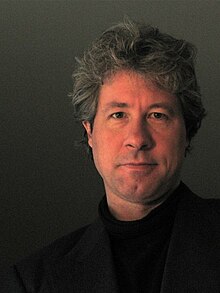
Back اريك ڤيرليند ARZ اریک فرلینده AZB Erik Verlinde German اریک فرلینده Persian Erik Verlinde French אריק ורלינד HE Erik Verlinde Italian Erik Verlinde Dutch Верлинде, Эрик Russian Ерік Верлінде Ukrainian
This article may be unbalanced toward certain viewpoints. (March 2018) |
Erik Verlinde | |
|---|---|
 Erik Verlinde in 2009 | |
| Born | Erik Peter Verlinde 21 January 1962 |
| Nationality | Dutch |
| Alma mater | Utrecht University |
| Known for | Verlinde algebra Matrix string theory Entropic gravity Emergent gravity |
| Awards | Spinoza Prize (2011) |
| Scientific career | |
| Fields | Theoretical physics |
| Institutions | |
| Thesis | Conformal field theory and its application to strings (1988) |
| Doctoral advisor | Bernard de Wit |
| Doctoral students | Miranda Cheng |
Erik Peter Verlinde (Dutch: [ˈeːrɪk ˈpeːtər vərˈlɪndə]; born 21 January 1962) is a Dutch theoretical physicist and string theorist. He is the identical twin brother of physicist Herman Verlinde. The Verlinde formula, which is important in conformal field theory and topological field theory, is named after him. His research deals with string theory, gravity,[1] black holes and cosmology. Currently,[2] he works at the Institute for Theoretical Physics at the University of Amsterdam.
At a symposium at the Dutch Spinoza-institute on December 8, 2009 he introduced a theory of entropic gravity. In this theory, gravity exists because of a difference in concentration of information in the empty space between two masses and its surroundings; he also extrapolates this to general relativity and quantum mechanics. He said in an interview with the newspaper de Volkskrant,[3] "On the smallest level Newton's laws don't apply, but they do for apples and planets. You can compare this to the pressure of a gas. Molecules themselves don't have any pressure, but a barrel of gas has." It appears that Verlinde's approach to explaining gravity leads naturally to the correct observed strength of dark energy.[4]
- ^ Cite error: The named reference
BT-2190814was invoked but never defined (see the help page). - ^ "University of Amsterdam homepage". 14 January 2020.
- ^ "De Volkskrant 27 January 2010" (in Dutch). Archived from the original on 11 November 2013. Retrieved 11 September 2011.
- ^ Koelman, Johannes. "It from bit: how to get rid of dark energy". Archived from the original on 19 January 2010. Retrieved 20 August 2011.